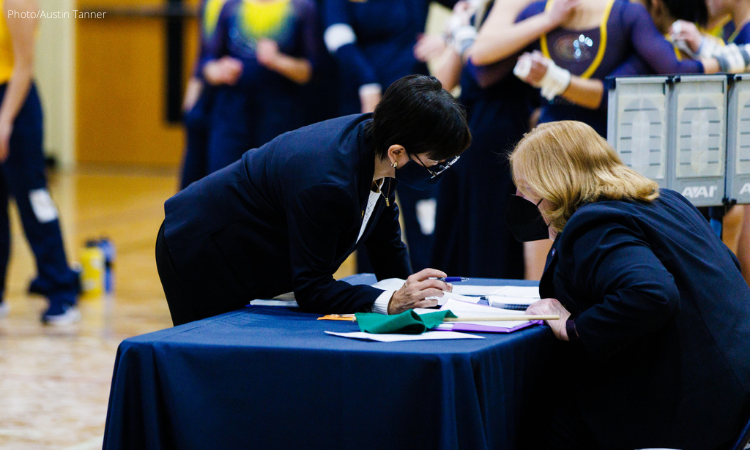If you haven’t heard it by now, “Hi, my name is Tavia Smith, and I’m a Centenary Gymnastics alum.” There. I got that out of the way. My entire career I believed that scoring was highly impacted by the C on my chest. My teammates and I could do the same routines that other athletes were doing and the score was at least three-tenths lower. Max deductions were taken when others received the minimum, if anything at all. It could be frustrating, infuriating even.
My sophomore year, it got so bad that my teammates and I went several weeks without peeking at the scoreboard. Afterall, it’s not about the score anyway. We judged our progress on the number of hit routines, focusing on a one-tenth-better-every-day mentality. My opinion of the DIII scoring bias was solidified in February 2019 when UW-Stout’s Shadae Boone received a 9.600 for a stuck Yurchenko one and a half. My jaw hit the floor. How could a 10.0 start value vault finally make its way into Division III gymnastics and be disrespected this way?
To this day, I cannot comprehend it.
If you want to say, “Tavia, Division III scores are just lower because the gymnastics is lower quality than the other divisions,” here’s some proof. On the Feb. 15 episode of the Gymcastic podcast, Spencer from The Balance Beam Situation calculated the difference between DIII scores at home compared to the same teams when competing away at DII and DI venues. Over the last 10 years, Division III programs have scored an average of 2.328 points higher when competing at a non-neutral venue against Division I and Division II schools. That goes to say that even if Division III schools do the same routines at two different locations, the team score is the equivalent of four falls lower if the meet is held at a Division III institution.
A bias exists. It’s a fact.
When you’re in the game, it’s easy to get defensive, think that the judges are out to get you. But if you think about it, the outcry for fair judging reaches far beyond Division III. Just a few weeks ago, the gymternet got Twitter fingers and fought for justice for Rutgers’ Emily Leese. The 9.825 she earned for her stuck 10.0 SV vault shocked the country. Today I want to explore the reasons for judging disparities that have zero to do with a person’s college of choice.
The Judges Are Actually Doing Their Job
As collegiate gymnastics fans, we’re spoiled. Seeing a 9.9-plus routine has become the new norm, especially among the power five conferences. Therefore, when we see what is perceived to be a strong routine going lower than 9.9, outrage ensues. However, sometimes we forget that there are little deductions that fall by the wayside. I’ve compiled a non-exclusive list of deductions that CAN be taken according to the code of points but are selectively or seldomly actually applied to high profile teams.
- Handstands: Each handstand can be up to a three tenth deduction if it’s outside of a 10-degree limit from vertical. That includes blind fulls, blind changes and half pirouettes that are supposed to land in the handstand position. That goes to say, we can’t get too mad when a routine with a pirouette finishing 45 degrees from vertical goes 9.825.
- A three-tenth landing deduction: Any landing that has a step or hop larger than shoulder width apart is a three-tenth deduction. I would be a very rich woman if I had a nickel for everytime I saw a vault with a huge hop or lunge go over 9.700.
- Leaps up to 180: If a split or straddle position is less than 180, the athlete has not met the compositional requirement for beam or floor. Tell me if you’ve ever seen a start value lowered for that. I’ll wait.
- Artistry: Hello. A judge can take up to three tenths simply for artistry… That means that if a floor routine has step-pose-step-pose choreography or is simply not to the music, technically the athlete can score as low as 9.700 even if all the skills are performed perfectly. Will that ever happen? Unlikely.
Trust me. There are plenty more where those came from, but I’ll stop there for fear of getting overwhelming in an attempt to prove the point. Just know that sometimes scores are lower simply because, according to the rules of the sport, they should be. Now, are the rules always applied? That’s a different story.
The Competition Environment
It’s no secret that an electric environment breeds insanely high scoring. With the increasing popularity of college gymnastics comes increasing expectations for 10.0s from the nation’s top performers, whether earned or not. That’s not to say these athletes are incapable of perfection. They are. I’ve seen it time and time again. Contrary to popular belief, we can still be fans of the nation’s finest if they hop on a dismount and the routine doesn’t go 10.0.
Calling for 10s
One of the common practices that has revolutionized the scoring crisis has been “calling for 10s.” Any stuck dismount in a large arena is met just the same: “TEN! TEN! TEN!” The crowd presses on. How could anyone say no to the roars of 10,000 voices? I don’t know if I could. Needless to say, in Division III venues, we were never trained to initiate such a chant, nor do we have sell-out crowds that could shake the building with voices alone. However, the sub-Division I schools have a strategy of their own to compensate. I’ll get to that momentarily.
Excessive Celebrations
Regardless of how the routine actually went, scream like you just did the best gymnastics of your life. Maybe then the judges will be too distracted to add up deductions. It sounds like a ridiculous sentiment, but trust me, it works…
TV Coverage
Don’t get me wrong. I love that college gymnastics is now being featured on major television networks. However, with that comes the need for television style drama. The camera crew often captures competitions that are closer than they should be with at least one 10.0, maybe two. Let’s face it, a 10.0 is much more likely to make SportsCenter’s daily Top 10. In fact, 10.0s from both Kiya Johnson and Trinity Thomas have made that very list this season. High scores make gymnastics more impressive to the novice viewer. I’ll accept this fact because the more gymnastics fans we have the better. However, it doesn’t negate the fact that unnecessarily high scoring cheapens the truly great routines that receive equivalent value. Biased scoring makes it difficult to differentiate between the OK, the good, the great and the true perfection.
The Build Up
Expectations
I don’t know if you’ve noticed this, and it could just be my own observation, but teams are more likely to get the scoring “benefit of the doubt” once they’ve proven themselves. For example, I never noticed Oklahoma getting what I’ll term “scoring gifts” until after it won a national championship. Let me be clear, everyone gets a scoring gift every now and then—one of those routines where you get off the equipment thinking “Well that could’ve gone better,” and then you see the score and say, “I guess not.” However, once the expectation of truly great, national championship-winning gymnastics is set, it’s easier to collect a few more presents. We’re already seen it happen with Michigan in 2022 after it won its first national title last year. With any luck, the Wolverines and the Big Ten are well on their way to scoring Christmas day.
You Have a 10? Have Two
This is just an extension of my last point. A gymnast can work for years to earn her first career perfect 10.0 and then get multiple in close succession. Most recently, junior Ragan Smith went two and half seasons without a perfect 10.0 and managed to get two in back-to-back weekends. This is not because the gymnastics is inherently “better.” She’s been performing beautiful gymnastics since arriving in Norman. In fact, she accumulated seven 9.975s prior to her first perfect score. Once a gymnast has crossed that barrier into the perfection zone, judges realize that it’s not unrealistic to throw that score into the universe. Smith now joins the crew of athletes where perfection really is possible.
My examples for this category only included Division I programs, but these observations still apply to the other divisions on a smaller scale. In the USAG circuit, Lindenwood has been the program to beat since 2015. It even qualified to NCAA regionals in 2019 for the first time in program history. The expectations are growing, and junior Gayla Griswold just got her first 9.975 on vault last weekend. The Lions’ time is coming.
Inexperience With Collegiate Judging
The Rules Still Exist
New judges have not had the time to fully immerse themselves in the world of college gymnastics where imperfection is awarded with perfect 10.0s. The code of points ingrained in their very being prior to taking the judging exam still is within recent memory. It’s OK. They’ll find out soon enough.
I Didn’t See It
Start values are really hard to come up with when the judge quite literally was looking down at scratch paper. I know this sounds crazy, but I have literally watched a video of a teammate’s bar routine and noticed a judge not looking up until her major release was already caught. In the judge’s defense, gymnastics is a very quick sport. The maximum amount of time is 90 seconds. Quite literally, one could blink and miss an entire vault. We’re all human. Life happens.
The problem is not inherently the code itself but the selective use of the code. Perhaps these scores that we perceive as “too low” only feel that way because the rest of the nation is being scored too high. It’s true that Division III gymnasts are subjected to a much harsher use of the code that more closely resembles the level 10 code of points, whereas much larger DI and DII programs get the more relaxed version where the lines are fuzzier. When UW-La Crosse’s head coach Kasey Crawford was asked about her opinions on Division III judging, she agreed. Although the Eagles’ scores feel fair, she hinted that judges sometimes don’t take all of the deductions in big environments or larger meets.
I’m writing this column so maybe we’ll be a little less quick to go to battle over the 9.85s of the world when there are athletes receiving 9.6s for stuck vaults. I just want us to enjoy the beautiful gymnastics from all teams. Maybe one of these days the code will be distributed evenly throughout all divisions, but with the high level of subjectivity in gymnastics, that day seems pretty far off. In the meantime, I’ll be busy enjoying gymnastics at all levels no matter the score.
READ THIS NEXT: Limited Leotard Budgets for Division III Programs Force Creative Thinking
Article by Tavia Smith
Like what you see? Consider donating to support our efforts throughout the year!





One comment